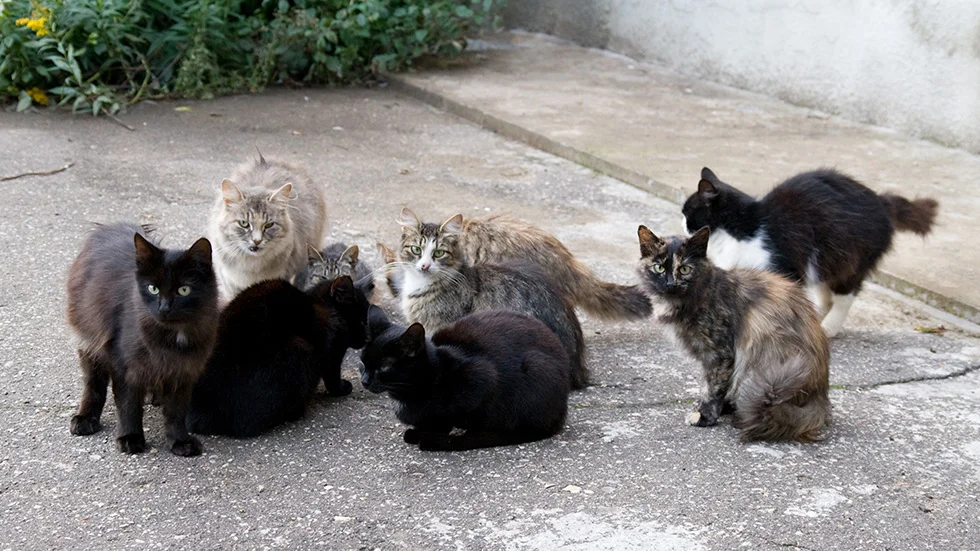Community cats, often referred to as stray or feral cats, are a common sight in many Moroccan neighborhoods. These cats live outdoors and are usually not owned by anyone, but they play a significant role in the local ecosystem. At the Humane Society of Morocco, we are dedicated to addressing the unique challenges faced by community cats through humane and effective solutions.
Our initiatives for community cats include Trap-Neuter-Vaccinate-Return (TNVR) programs, which help control the population and improve the health of these cats. By humanely catching community cats, spaying or neutering them, and then returning them to their territories, we reduce the number of kittens born on the streets and enhance the overall well-being of the adult cats.
We also work to raise awareness about the importance of community cats and promote coexistence strategies that benefit both the cats and the communities they inhabit. Through education and collaboration, we aim to create a safer and healthier environment for community cats across Morocco.

Sometimes when we see a cat in the community, we might think they need our help. Here are some tips on what you should – and shouldn’t – do when coming across a community cat in Morocco
What is a community cat?
Community cats are the felines we see in our community. These cats come from a variety of backgrounds. Some community cats are feral. Some community cats were previously owned and abandoned. Other community cats are owned but are outside near their home.
Community cats go by many names: neighborhood cats, stray cats, roaming cats, and more. Essentially, every cat that you encounter while outside is a community cat.
How can I help community cats?
When you see a cat in the community, the first question you must ask is: Is the cat healthy? If the cat looks healthy and uninjured the best thing you can do is leave them alone. It is best to leave the cat alone because:
The cat I see doesn’t look injured and/or unhealthy. What should I do?
If the cat looks healthy and uninjured, the best thing to do is leave the cat alone.
If the cat requires medical assistance, call a veterinarian.
I don’t like when the community cats come into my yard. What can I do to deter them?
It’s important to remember that removing a cat from your area will not reduce the number of cats. If there is a nearby food or water source, more cats will move into the area.
However, there are plenty of humane ways to deter community cats from entering your yard. Community cats are likely using your space because it is providing a source of food or shelter. Removing food sources and blocking access to hiding places can deter a community cat. You can also:
For more information, visit our page: Discouraging Roaming Cats.
I don’t mind having community cats in my yard. What can I do to help them?
Some city councils, charities, or even neighbors run a Trap, Neuter, and Return program for cats in non-residential areas. It is designed to improve the lives of community cats and reduce their numbers. Cats in non-residential areas are trapped by people like you, brought to a veterinarian for a spay/neuter surgery, vaccinated, and then released back into their community.
In some areas of Morocco, we experience extreme weather – both hot and cold. Find our tips for caring for community cats in cold weather and hot weather.
| Cookie | Duration | Description |
|---|---|---|
| cookielawinfo-checkbox-analytics | 11 months | This cookie is set by GDPR Cookie Consent plugin. The cookie is used to store the user consent for the cookies in the category "Analytics". |
| cookielawinfo-checkbox-functional | 11 months | The cookie is set by GDPR cookie consent to record the user consent for the cookies in the category "Functional". |
| cookielawinfo-checkbox-necessary | 11 months | This cookie is set by GDPR Cookie Consent plugin. The cookies is used to store the user consent for the cookies in the category "Necessary". |
| cookielawinfo-checkbox-others | 11 months | This cookie is set by GDPR Cookie Consent plugin. The cookie is used to store the user consent for the cookies in the category "Other. |
| cookielawinfo-checkbox-performance | 11 months | This cookie is set by GDPR Cookie Consent plugin. The cookie is used to store the user consent for the cookies in the category "Performance". |
| viewed_cookie_policy | 11 months | The cookie is set by the GDPR Cookie Consent plugin and is used to store whether or not user has consented to the use of cookies. It does not store any personal data. |
Create an account or sign in to save pets you love.
Don't have an account? Contact us
Before you proceed with your adoption application, please review and accept our data handling practices:
Note: By clicking "I Agree & Continue", you will be redirected to an external application form. This tracking system logs your interest but does not capture data from the external form.
Create an account or sign in to save pets you love.
Don't have an account? Contact us
Before you proceed with your adoption application, please review and accept our data handling practices:
Note: By clicking "I Agree & Continue", you will be redirected to an external application form. This tracking system logs your interest but does not capture data from the external form.